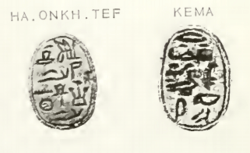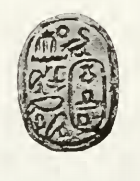Neferhotep I facts for kids
Quick facts for kids Neferhotep I |
|
|---|---|
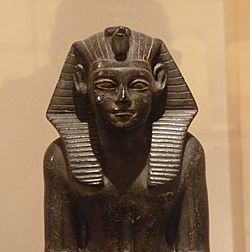
Statue of Neferhotep I from the Faiyum, Archaeological Museum of Bologna.
|
|
| Pharaoh | |
| Reign | 11 years and 1–4 months, 1747—1736 BC, 1742–1733 BC, 1741–1730 BC, c. 1740 BC, 1740–1729 BC, 1721–1710 BC, 1705–1694 BC, (13th Dynasty) |
| Coregency | Sihathor, then Sobekhotep IV |
| Predecessor | Sobekhotep III |
| Successor | Sihathor as coregent, then Sobekhotep IV |
| Consort | Senebsen |
| Children | Haankhef, Kemi, Wahneferhotep |
| Father | Haankhef |
| Mother | Kemi |
| Burial | uncertain, possibly tomb S9 in Abydos, see text |
Khasekhemre Neferhotep I was an Egyptian pharaoh (king) who ruled during the middle of the 13th Dynasty. He reigned for about 11 years in the 18th century BC. This time is often called the late Middle Kingdom or early Second Intermediate Period.
Neferhotep I came from a family in Thebes that had a military background. His grandfather was an army officer. It is not clear how he became king after Sobekhotep III. Some historians think he might have taken the throne.
He was likely a ruler at the same time as famous kings like Hammurabi of Babylon. Not much is known about what he did during his reign. However, a special stone slab called a stela from Abydos tells us about him. It describes how he ordered a statue of the god Osiris to be made exactly as the gods had instructed long ago.
Near the end of his rule, Neferhotep I shared the throne with his brother, Sihathor. This co-rule lasted for a few months. When Sihathor died, Neferhotep I likely appointed another brother, Sobekhotep IV, to rule with him. Sobekhotep IV became the next pharaoh and ruled for almost ten years. The reigns of Neferhotep I and Sobekhotep IV were a very strong period for the 13th Dynasty.
Contents
Who Was Neferhotep I's Family?
His Family Background
Neferhotep I came from a family in Thebes that was not royal. They had a history in the military. His grandfather, Nehy, was an "officer of a town regiment." Nehy's wife was Senebtysy.
Neferhotep's father was Haankhef, and his mother was Kemi. Neither of them were born into the royal family. Haankhef was called "God's father" and "royal sealer." Kemi was called "king's mother." This shows they were important but not royal by birth.
The Turin King List, an ancient record of pharaohs, even mentions Haankhef as Neferhotep I's father. This is very unusual because the list usually only names kings. This shows how important Neferhotep's family was.
It's interesting that Neferhotep I and his brothers, Sobekhotep III and Sobekhotep IV, openly shared their non-royal origins. This was different from how Egyptian kings usually showed their right to rule. They might have done this to show they were different from earlier kings.
His Children and Successors
Neferhotep I had at least two children with his wife, Senebsen. They were named Haankhef and Kemi, just like his parents. He might have had another son named Wahneferhotep.
Even though he had children, Neferhotep I chose his brother, Sihathor, to rule with him. Sihathor died shortly after. Then, another brother, Sobekhotep IV, became king after Neferhotep I.
Sobekhotep IV said he was born in Thebes. This means Neferhotep I was likely born there too. Even though the capital city of Egypt was Itjtawy in the north, many important people came from Thebes in the south.
What Do We Know About Neferhotep I's Reign?
Evidence of His Rule
We know about Neferhotep I from many objects found across a large area. These objects include:
- Over 60 scarab seals (small, beetle-shaped amulets with inscriptions).
- 2 cylinder-seals.
- A statue from Elephantine.
- 11 rock carvings from different places in Egypt.
- Two stone shrines called naoses found in Karnak.
- A small statue from the Faiyum region, now in a museum in Bologna.
These objects show that Neferhotep I was an important ruler. They also mention his family and high-ranking officials who worked for him.
King Lists and How Long He Ruled
Neferhotep I is listed on two important ancient Egyptian king lists:
- The Karnak king list.
- The Turin King List.
The Turin King List says he ruled for 11 years and 1 to 4 months. This was one of the longest reigns in the 13th Dynasty.
When Did Neferhotep I Rule?
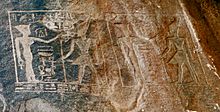
Historians agree that Neferhotep I ruled after Sobekhotep III and before Sobekhotep IV. Because his parents were not royal, many experts believe he took the throne rather than inheriting it. His family's military background might have helped him do this.
The exact dates of his reign vary among historians. Some say he started ruling around 1740 BC, while others suggest around 1700 BC.
How Much of Egypt Did He Rule?
Some historians believe that when Neferhotep I became king, Egypt might have already been divided. They think another dynasty, the 14th Dynasty, might have controlled the eastern part of the Nile Delta. This could explain why very few objects from Neferhotep I have been found in that area.
However, other historians believe he ruled over all of Egypt. They point to objects found in the Levant (a region in the Middle East), like a stela from Byblos. These objects suggest he kept strong trade connections with other regions.
What Did Neferhotep I Do?
Even though many objects from his time exist, we don't know much about his daily activities. We do know he ordered some building projects in Karnak. Archaeologists found two large stone shrines there that held statues of him. One shrine had a double statue of Neferhotep I holding hands with himself!
His most important surviving monument is a large stone slab (stela) found in Abydos. It dates to his second year as king. This stela is special because it describes how a king decided to create a sculpture.
The stela says that Neferhotep I, while in his palace, wanted a statue of the god Osiris made for a yearly festival in Abydos. He asked his officials to find ancient writings that explained how to make divine images. After finding these instructions, he ordered the statue to be made from silver, gold, and copper. He even watched the work himself. Finally, the king went to Abydos to celebrate the festival.
Overall, Neferhotep I's time as king was likely a good one for Egypt. Many private monuments were made during his and his brother's reigns, and some very beautiful artworks were created.
Where Is Neferhotep I's Tomb?
As of today, Neferhotep I's tomb has not been officially found. However, archaeologists believe it might be in Abydos. Since 2013, a team from the University of Pennsylvania has been digging in a royal burial ground in Abydos. This area is near the large tomb complex of Senusret III.
One large tomb, known as S10, is thought to belong to Neferhotep's brother, Sobekhotep IV. Because of this, experts like Josef W. Wegner suggest that the nearby large tomb, S9, could be Neferhotep I's tomb. Both kings were very active in the Abydos area during their reigns.
Older ideas about his tomb included a pyramid at el-Lisht. This idea came from finding small objects with Neferhotep's name there. Also, a small statue of a prince named Wahneferhotep was found near a pyramid in Lisht. This prince was likely Neferhotep I's son, and he might have been buried near his father's pyramid.
Another idea was that the Southern South Saqqara pyramid could be his burial place. This pyramid has two special burial chambers, which might have been for two wealthy brother kings, like Neferhotep I and Sobekhotep IV.
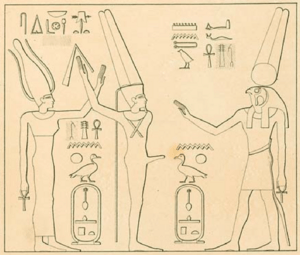
We don't know how Neferhotep I died after ruling for eleven years. His successor was his brother, Sobekhotep IV. Another brother, Sihathor, is listed as a successor on the Turin King List. But it seems Sihathor only ruled for a few months with Neferhotep I and never became a king on his own. He likely died before Neferhotep.
After Sihathor's death, Neferhotep I might have appointed his younger brother, Sobekhotep IV, to rule with him. There are two carvings from Sehel that show Neferhotep I, Sihathor, and Sobekhotep IV together. This could mean they ruled at the same time, even though Sihathor is shown as dead in these carvings. Another carving shows the names of Neferhotep I and Sobekhotep IV side-by-side. Some experts think this means they ruled together, while others believe Sobekhotep IV simply honored his deceased brother.
Neferhotep I and Other Ancient Kingdoms
A special stone slab with Neferhotep I's name is very important for historians. It helps connect the timeline of ancient Egypt with the timelines of other kingdoms in the Near East. This stela shows a "Governor of Byblos, Yantinu." Byblos was a city in what is now Lebanon.
Yantinu is likely the same person as "King of Byblos Yantin-'Ammu," who is mentioned in ancient records from the city of Mari. These Mari records mostly come from the time of Mari's last king, Zimri-Lim, who was a contemporary of Hammurabi of Babylon. This connection helps historians understand that Neferhotep I, Yantinu, Zimri-Lim, and Hammurabi lived around the same time.
See also
 In Spanish: Neferhotep I para niños
In Spanish: Neferhotep I para niños


